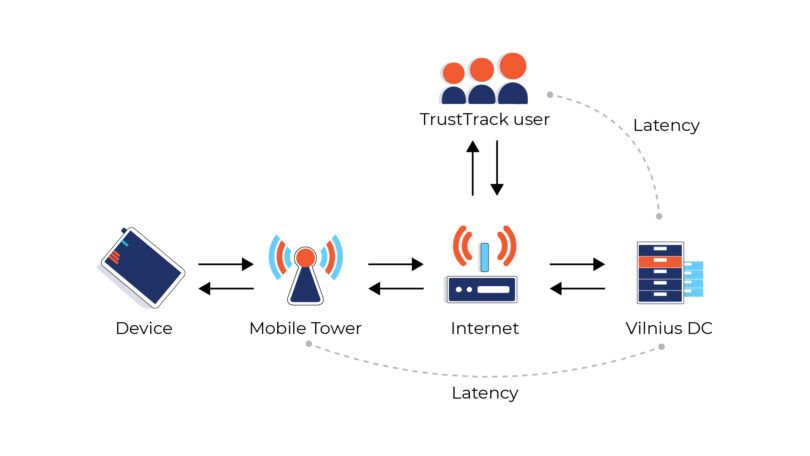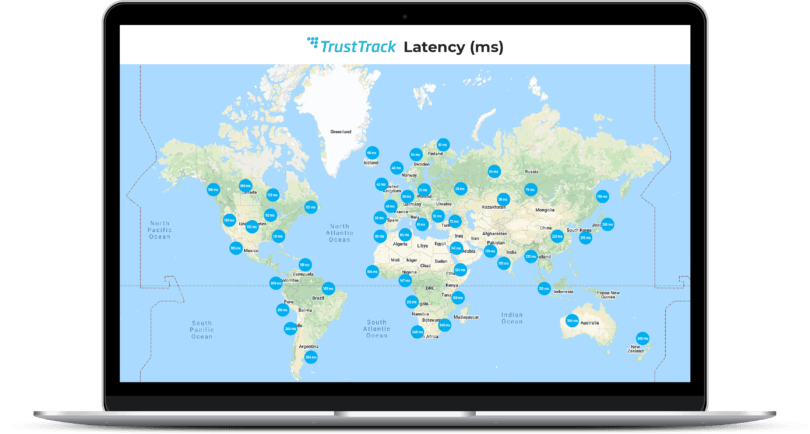The IT department at Ruptela has many different responsibilities and significantly contributes to the overall efficiency of various processes at Ruptela, including the continued operation of the TrustTrack software. A series of articles will present the diverse activities and functions the IT has, each of them covering and explaining applicability or technical aspects of the software, IT infrastructure, and the day-to-day life of Ruptela’s IT team.
Latency on TrustTrack
How does TrustTrack work?
TrustTrack software has many functionalities that can benefit any person involved in the logistics business. For instance, by using TrustTrack, users can track their vehicles, stay informed about the status of each of them, manage tachograph data and files, encourage the habit change of drivers in terms of Eco-Drive parameters, and many more. Currently, there are more than 180 000 active objects on TrustTrack worldwide, and it is self-evident that one of the key responsibilities of the IT team at Ruptela is to ensure platform stability and continuous operations.
Latency
Ruptela operates TrustTrack platform using privately run and owned IT hardware supplied by the world-class vendors like Dell, Fujitsu, HPE, and others and hosts it with the most reliable data center (DC) providers in Vilnius, Lithuania. Since the TrustTrack value proposition starts from a “dot on the map” – representation of the vehicle position in the user interface, a persistent arising question is whether we can compete with local companies in Asia or Latin America.
The short answer would be “Yes, there is no doubt we can!”, the long explanation touches upon the notion of latency – the element indicating the network quality worldwide.
Latency is a measure of delay. In a network, latency measures the time it takes for some data to get to its destination across the network. Usually, it is measured as a round-trip delay – the time taken for information to get to its destination and back again. The round-trip delay is an essential measure because a device that uses the Internet sends a limited amount of data to its destination and then waits for an acknowledgment to come back before sending any more. Thus, the round-trip delay has a crucial impact on the performance of the network.
Latency is usually measured in milliseconds (ms).
Typical approximate values for latency that anyone might experience include:
- 800ms for satellite
- 120ms for 3G cellular data
- 60ms for 4G cellular data (often used for 4G WAN and Internet connections)
- 10-20ms for broadband Internet connections.
One may wonder why this latency is so important. People often assume that high performance comes from high bandwidth, which, admittedly, is essential but does not provide a full picture. The bandwidth of a network refers to its capacity to carry traffic. It is measured in bit per second, commonly, Megabits per second (Mbps). Higher bandwidth means that more traffic can be carried, for example, more simultaneous conversations or smoother downloads. However, it does not imply how fast that communication will take place (although if you attempt to put more traffic over a network than the available bandwidth, you’ll get packages of data being discarded and re-transmitted later, which will degrade your performance).
In our case, a data package is traveling from the device (vehicle, somewhere on the Earth) to the data center (DC) in Vilnius. Once it reaches our servers in a DC, it is extracted, processed, and the result is saved in a database. From that moment, the vehicle position can be displayed in the TrustTrack user interface. To view that position, another stream of data has to come out of the DC back to the user. In this chain – two latency numbers are crucial. First, the latency between a country where the vehicle is and Lithuania; Second – the latency between Lithuania and the country where the user is looking at the map on TrustTrack.

It is essential to mention that other factors impact the time required for a dot on the map to appear, namely, the connection quality between a device and the nearest cellular tower, as well as the quality of the user’s internet provider.
We have measured the latency between our DC and the different parts of the world. For example, the latency between Vilnius and Senegal is 104 milliseconds or 0.1 seconds, literally, less than a blink of an eye, even if this route is traveled several times. Spain – 53 milliseconds, Vietnam – 285 milliseconds.
The time needed for the data package to be extracted and processed is also crucial. Once the telemetry data packet reaches our servers in the DC, typically, it can be displayed to end-users, on average, in less than 3 seconds. This number is an excellent example that TrustTrack can provide near-real-time data collection, processing, and display around the globe. During daily peak times, we are simultaneously processing more than 1800 data packets per second. More than 6 000 000 per hour and this is going on for 24/7 non-stop.
Such numbers show that TrustTrack is a very reliable platform with data processing taking place every second.
 EN
EN
 ES
ES LT
LT PL
PL BR
BR UA
UA MX
MX
